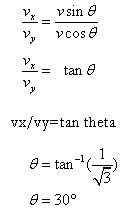Solved Examples of Finding Vector Components
- A baseball is hit with a velocity of 14 m/s at angle of 30° with the horizontal direction. What are the horizontal and vertical vector components of the velocity vector?
Solution:
Given: v = 14 m/s, horizontal component vx = ? and the vertical component vy = ?
Since the velocity vector makes angle θ with the horizontal then

and

Substituting the values of V and θ = 30° we get,

and the vertical component is


-
A bullet shot from the gun at an angle of 60°. Its horizontal component is 40 m/s. What is the actual velocity?
Solution:
Given: θ = 60°, vx = 40 m/s and v = ?
The horizontal component of the velocity.
- The horizontal and vertical components of the velocity vector of the foot ball are 10√3m/s and 10 m/s respectively. What is the angle at which the ball is thrown?
Solution:
Given:
We know, and
and  . Dividing these two equations we get
. Dividing these two equations we get
